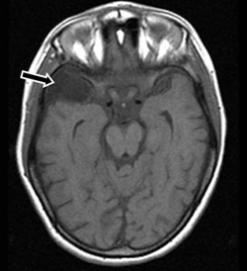Arachnoid cysts are "pockets" in the clear, thin covering of the brain called the arachnoid. They are very commonly found in brain imaging studies.
The fluid that normally surrounds the brain (cerebrospinal fluid, or CSF) can accumulate in these pockets and create an arachnoid cyst. These cysts are typically found on the outside of the brain and are thought to be present since birth. They can occur almost anywhere on the surface of the brain.
Symptoms
Although the symptoms can vary depending on where the cyst is, the most common symptoms are:
- Headaches
- Nausea or vomiting
- Seizures
- Large or unusual size of the head
- Developmental delay
- Weakness on one side of the body
Diagnosis
Arachnoid cysts are usually discovered "incidentally" (or by accident) when brain images are performed for another reason with computed tomography (CT or CAT scan) or magnetic resonance imaging (MRI), such as after a trauma. Sometimes further imaging, such as a more detailed MRI scan, is needed to make sure that the cyst is not a brain tumor.
Treatment
When someone has no problems related to the arachnoid cyst, surgery is usually not recommended. Patients are usually seen back for a follow-up and for repeat MRI studies to make sure the arachnoid cyst is not getting bigger or causing any problems that might require surgery.
Surgery
Surgery is usually done on patients who have symptoms from compression of the brain by the cyst or if the cyst is getting larger on imaging studies.
The goal of surgery is to drain the fluid from the cyst. Surgical options include placing a catheter into the cyst and draining the cyst fluid into another body cavity (shunting) or opening the cyst up directly and draining the fluid into the space surrounding the brain (craniotomy for fenestration). Your neurosurgeon will work with you to determine which option would be recommended for your child.
Surgery usually takes between two and four hours. After the operation, children usually stay in the hospital for two to four days. Most children can resume regular activities, including school, approximately two weeks after surgery. High-risk activities, including contact sports, are usually restricted for three months after surgery.
Page reviewed on: Nov 19, 2009
Page reviewed by: Susan R. Durham, MD, MS
